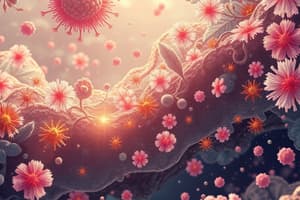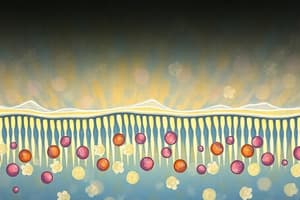Podcast
Questions and Answers
Which of the following best describes the random movement of molecules in a solution?
Which of the following best describes the random movement of molecules in a solution?
- Nonexistent
- Dependent on external forces
- Chaotic and constant (correct)
- Ordered and predictable
What causes the dispersal of a dye when it dissolves in water?
What causes the dispersal of a dye when it dissolves in water?
- Gravity
- Electromagnetic forces
- Heat (correct)
- Chemical reactions
What factors affect the rate of dispersal of a dye in a solution?
What factors affect the rate of dispersal of a dye in a solution?
- Presence of other solutes
- Color of the dye
- Size of the dye molecules (correct)
- Shape of the container
How can we observe the movement of molecules in biological systems?
How can we observe the movement of molecules in biological systems?
What is the ultimate goal of the net movement of molecules in a solution?
What is the ultimate goal of the net movement of molecules in a solution?
Which of the following factors does NOT affect the rate of diffusion?
Which of the following factors does NOT affect the rate of diffusion?
What is the primary determinant of a substance's direction of diffusion?
What is the primary determinant of a substance's direction of diffusion?
What is the main function of cellular membranes?
What is the main function of cellular membranes?
What term describes the passive, directional movement of molecules?
What term describes the passive, directional movement of molecules?
What determines the rate of diffusion, in addition to the concentration gradient?
What determines the rate of diffusion, in addition to the concentration gradient?
Study Notes
Diffusion
- Random movement of molecules in a solution is described as Brownian motion.
- Dispersal of a dye in water is caused by the random movement of molecules, resulting in uniform distribution.
- Factors that affect the rate of dispersal of a dye in a solution include:
- Concentration gradient
- Temperature
- Surface area
- Shape and size of molecules
- Movement of molecules in biological systems can be observed through:
- Microscopy
- Dye dispersion
- Observation of cellular processes
- The ultimate goal of the net movement of molecules in a solution is to achieve equilibrium, where the concentration of molecules is uniform throughout the solution.
Factors Affecting Diffusion
- The rate of diffusion is NOT affected by the color of the dye.
- The primary determinant of a substance's direction of diffusion is the concentration gradient.
- In addition to the concentration gradient, the rate of diffusion is also determined by the:
- Temperature
- Surface area
- Shape and size of molecules
Cellular Membranes
- The main function of cellular membranes is to regulate the movement of molecules in and out of cells.
- The passive, directional movement of molecules is described as diffusion.
Studying That Suits You
Use AI to generate personalized quizzes and flashcards to suit your learning preferences.
Description
Test your knowledge on molecular motion and diffusion with this quiz! Learn about how molecules move and distribute in solutions, and understand why a dissolved molecule tends to move from areas of high concentration to low concentration.




